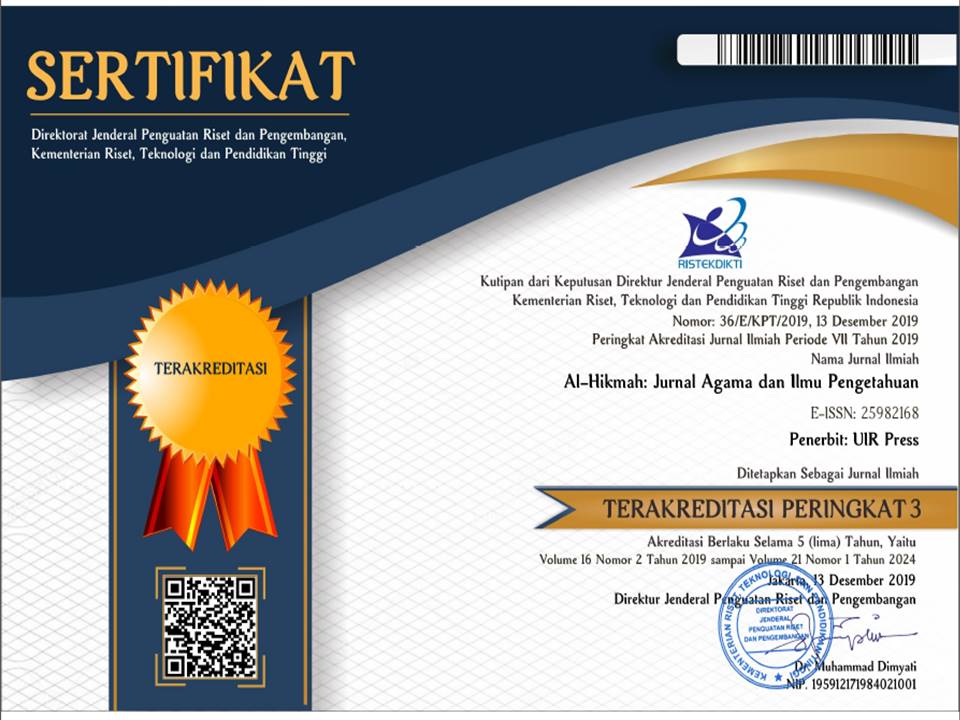Penerapan Positive Teaching Sebagai Langkah Awal Dalam Membangun Sekolah Positif Di Sekolah YLPI (Yayasan Lembaga Pendidikan Islam)
DOI:
https://doi.org/10.25299/al-hikmah:jaip.2022.vol19(1).8983Keywords:
Mental Health, Positive School, Positive TeachingAbstract
One critical factor students influence learning a better direction lies in qualified teachers. One indicator of teacher quality application is positive teaching. This study aims to which teachers in schools to implement positive teaching. The subjects in this study consisted of teachers SD, SMP and SMA at Pekanbaru Islamic Education Foundation (YLPI). This study used a simple random sampling technique with a total number of samples is 60 people. Data was collected using a positive teaching scale which has 8 component scales, a) attention, b) trust, c) respect for differences, d) goals, e) planning, f) motivation, g) expectations and h) contributions to the community. Data analysis used quantitative descriptive with percentage method. The results showed that the percentage of large, medium and low components was in the trust component as many as 12 people (20%), community contributions as many as 49 people (81,66%), and goals as many as 11 people (18,33%). And it is known that the application of positive schools through positive teaching is in the medium category, which is 73,33%.
Downloads
References
Allison, N. G. (2020). Students’ Attention in Class: Patterns, Perceptions of cause and A Tool for Measuring Classroom Quality of Life. Journal of Perspectives in Applied Academic Practice, 8(2), 58–71.
Arikunto, S. (2019). Prosedur Penelitian. Rineka Cipta.
Aulia, F. (2015). Aplikasi Psikologi Positif dalam Konteks Sekolah. In Seminar Psikologi Dan Kemanusiaan, 120–124.
Azwar, S. (2012). Metode Penelitian. Pustaka Pelajar.
Barreto, M., & Ellemers, N. (2002). The Impact of Respect versus Neglect of Self-Identities on Identification and Group Loyalty. Personality and Social Psychology Bulletin, 28(5), 629–639.
Eliasa, E. I. (2011). Pentingnya Sikap Respek Bagi Pendidik Dalam Pembelajaran. Majalah Ilmiah Pembelajaran, 7(1), 1–15.
Fejova, A., & Uhlarikova, J. (2018). Teacher’S Academic Optimism, Hope and Zest for Work as Predictors of Pupils’ School Achievement. Proceedings of EDULEARN18 Conference, 9860–9866.
Gunawan, A., & Sunardi, H. (2016). Pengaruh Kompensasi dan Disiplin Kerja Terhadap Kinerja Karyawan pada PT. Gesit Nusa Tangguh. Jurnal Ilmiah Manajemen Bisnis Ukrida, 16(1), 1–12.
Hadi, I. A. (2017). Pentingnya Pengenalan tentang Perbedaan Individu Anak dalam Belajar. Jurnal Inspirasi, 1(1), 71–92.
Hasbullah, & Boon, Y. (2015). Keyakinan Diri sebagai Dimensi Psikologis Guru di Sekolah Menengah Atas di Makassar. Journal of Educational Science and Technology (EST), 1(3), 1–9.
Kardo, R., & Yuzarion. (2017). Sikap Guru terhadap Peserta Didik dalam Belajar. Ilmu Pendidikan: Jurnal Kajian Teori Dan Praktik Kependidikan, 2(2), 189–195.
McDonald, T. (2010). A Positive Learning Framework for Classroom Management. Classroom Management: Engaging Students in Learning, 1–29.
Muhtadi, M. (2018). Pendidikan Humanistik dalam Perspektif Al-Qur’an. Institut PTIQ Jakarta.
O’Grady, P. (2013). Positive Psychology in The Elementary School Clasroom. W. W. Norton & Company.
Pemerintah Pusat Republik Indonesia. (2003). Undang-Undang (UU) Nomor 20 Tahun 2003 tentang Sistem Pendidikan Nasional. Sekretariat Negara.
Purwanti, E. (2017). Teachers’ Strategies in Getting Students’ Attention During Transition in EFL Classroom (A Case Study on English Teacher in a Junior High School. Universitas Negeri Makassar.
Retnawati, H. (2017). Teknik Pengambilan Sampel. In Disampaikan Pada Workshop Update Penelitian Kuantitatif, Teknik Sampling, Analisis Data, Dan Isu Plagiarisme, 1–7.
Sabarin, G., & Djunaidi, A. (2018). Peran Guru dan Masyarakat Sekolah dalam Menghadapi Pengaruh Media Sosial terkait dengan Kenakalan Remaja di SMA Negeri 1 Mauponggo. CIVICUS: Pendidikan-Penelitian-Pengabdian Pendidikan Pancasila dan Kewarganegaraan, 6(2), 73.
Seligman, M. E. P. (2011). Flourish: A Visionary New Understanding of Happiness and Well-Being. Free Press.
Sieberer-Nagler, K. (2015). Effective Classroom-Management & Positive Teaching. English Language Teaching, 9(1), 163.
Snyder, C. R., & Lopez, S. J. (2009). Oxford Handbook of Positive Psychology. Oxford University Press.
Susetyo, F. Y. (2016). Psikologi untuk Indonesia Tangguh dan Bahagia. Gadjah Mada University Press.
White, M., & Kern, M. L. (2018). Positive Education: Learning and Teaching for Wellbeing and Academic Mastery. International Journal of Wellbeing, 8(1), 1–17.
Wibowo, Y. S., Setiawati, F. A., Qodriah, S. R., & Ayriza, Y. (2021). Positive Education: Exploring Students’ Well-Being Framework in Indonesia. Cakrawala Pendidikan, 40(3), 762–771.







